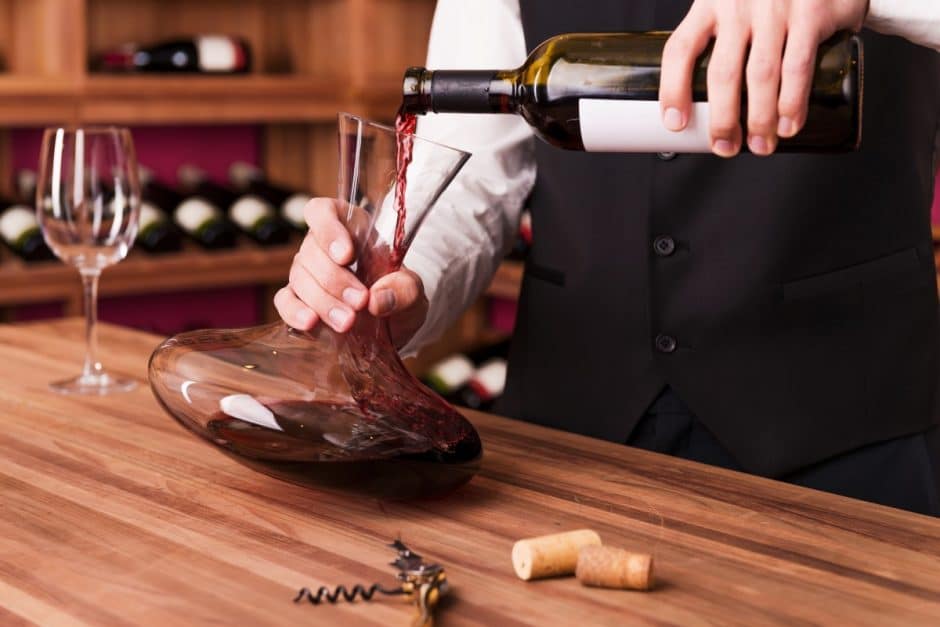What exactly is decanting wine? Is decanting a bottle of wine difficult to do, and is it worth it?
Simply stated, decanting is the process of pouring wine (typically a red) from a bottle and into another receptacle before serving. Perhaps it sounds a little crazy to think this will improve the taste of the wine, but according to the folks at Black Walnut Winery, it works.

Sometimes it’s difficult to know if you actually have sediment in an older darker bottle. Shake the bottle a bit then set it down on a flat surface. Light a candle, flashlight or your smartphone behind the neck of the bottle to see if little flakes of sediment are floating. If the answer is yes, then let’s explain the process here.
Why Do We Decant?
Lance Castle, co-owner and resident wine connoisseur at Black Walnut Winery, explains, “There are two reasons to decant. One is to keep sediment from getting into the wine glass. Most red wines that are designed for aging are bottled in a ‘Bordeaux’ style bottle. These bottles have what’s known as a ‘shoulder’ (just to the south of the stem base) designed to catch sediment as the wine is poured carefully into a decanter.” The sediment is often astringent and doesn’t give a very good mouth-feel when it hits your palate. You can pour the remainder of the bottle through a strainer or cheesecloth if you’d like. It may not have quite the depth of the first pour, but is still quite palatable.
 “The other reason we decant is to aerate or add oxygen to a younger more tannic wine,” notes Castle. “Oxygen is wine’s enemy when it’s being produced and can contribute to damaging a wine far before it’s ready to drink. However, when a wine is opened and ready to imbibe, oxygen can help release aromas in the wine as well as mellow the tannins that may be on the youthful side.”
“The other reason we decant is to aerate or add oxygen to a younger more tannic wine,” notes Castle. “Oxygen is wine’s enemy when it’s being produced and can contribute to damaging a wine far before it’s ready to drink. However, when a wine is opened and ready to imbibe, oxygen can help release aromas in the wine as well as mellow the tannins that may be on the youthful side.”
Castle recommends using an aerator as well; this can help get additional oxygen into the wine as you decant it. Black Walnut Winery sells a product called Vinturi, which has many ports to allow more air to mix with the wine.
Just released at the end of 2016, Black Walnut’s newest star, 2012 Tryst, shows an abundant amount of tannins that can be perceived as dry in the mouth. However, by mixing in more oxygen, the wine softens nicely and is a delight to sip.
How Do We Decant?
You don’t need to be a sommelier to decant. Hold your decanter at a 45-degree angle, with a light source behind it. You should see the trail of sediment, almost like silt, coming up across the bottle’s neck. Keep pouring slowly until sediment is about to pass the neck. It takes a bit of a steady hand, but it’s quite simple once you do it.

Choosing a Decanter
According to New York magazine, the principles of choosing stemware also apply to decanters. A clear, crystal decanter allows you to see the wine at its best; overly decorated or colored decanters obscure the wine. Moreover, just as with your stemware, be sure that your decanter is spotless and free from any musty cupboard aromas. Rinse it with mineral water to remove any residual chlorine odor. And never clean your decanter with detergent; the shape of a decanter makes it very difficult to get the soapy residue out. Instead, use a mixture of crushed ice and coarse salt—they’ll remove any residual wine without leaving behind an aroma of their own.
Stay in touch on Facebook, Instagram and the Black Walnut Winery website for information on the latest happenings at the winery (and the latest wines!).
Find Black Walnut Winery at 3000 Lincoln Highway in Sadsburyville; phone: (610) 857-5566. Hours are Wednesday–Sunday, 12–6 p.m. (or by appointment).
The Black Walnut Tasting Room is located at 260 Bridge St. in Phoenixville; phone: (484) 924-8740. Hours are Wednesday–Thursday, 4–9 p.m.; Friday, 4–10 p.m.; Saturday, 11 a.m.–10 p.m.; and Sunday, 1–8 p.m. (or by appointment).
- Top and middle photos: Ed Williams
- Bottom photo: BigStock



